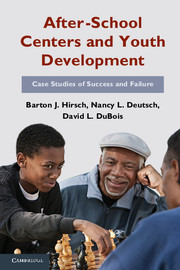Book contents
- Frontmatter
- Contents
- Figure and Tables
- Preface
- Introduction
- Midwest Center
- 2 Pockets of Excellence
- 3 Pocahontas Joins the Tribe
- 4 Bill: The Pros and Cons of Being One of the Guys
- 5 Putting It All Together: Midwest Center
- North River Center
- West River Center
- Conclusion
- Appendix Data Sources
- References
- Index
5 - Putting It All Together: Midwest Center
Published online by Cambridge University Press: 05 June 2012
- Frontmatter
- Contents
- Figure and Tables
- Preface
- Introduction
- Midwest Center
- 2 Pockets of Excellence
- 3 Pocahontas Joins the Tribe
- 4 Bill: The Pros and Cons of Being One of the Guys
- 5 Putting It All Together: Midwest Center
- North River Center
- West River Center
- Conclusion
- Appendix Data Sources
- References
- Index
Summary
At this point, it is time to take a step back and consider what we have learned by our several studies of the Midwest after-school center. We hope in these mini-chapters – including the ones that follow the case studies of the other centers – to contribute to an integrative understanding of how comprehensive after-school centers influence youth outcomes. As part of this effort, we pay particular attention to distinctive features of comprehensive centers. Centers of this sort are complex organizations, and our analytic framework seeks to integrate both organizational and person-level factors. Grounded in the experiences of Pocahontas and Bill, as well as the organizational-level study, our objective is to abstract broader insights from those accounts. We therefore need to shift gears somewhat and consider what more general principles may be at work, which we can then reexamine in future chapters.
In Chapter 1, we introduced the concept of a PARC (program, activity, relationship, culture) to capture the multifaceted aspect of youth engagements at these centers. For both Pocahontas and Bill, this proved to be a very useful concept. For both of them it was critical to find one PARC that meaningfully engaged them. A meaningful PARC anchored their continued participation in Midwest and fostered developmental growth. Pocahontas found this with Manuel around math, Bill with Manuel around chess. In these instances, the person was an adult staff member; it may be possible for a peer to serve in this role as well, but our research was oriented toward youth relationships with adult staff, so we are not in the best position to address this question.
- Type
- Chapter
- Information
- After-School Centers and Youth DevelopmentCase Studies of Success and Failure, pp. 121 - 126Publisher: Cambridge University PressPrint publication year: 2011

